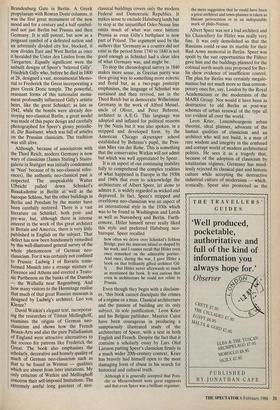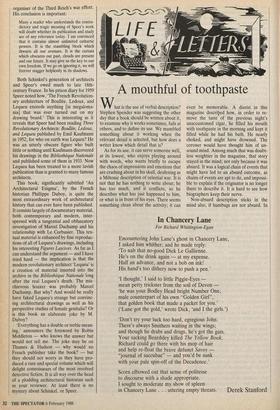Neo-classical tradition in Germany
Gavin Stamp
It was always my ambition to be the legitimate heir of the Berlin classicists,' recorded Albert Speer in his diary in Spandau prison in 1955, 'and to this day it seems to me that the garden façade of the new Chancellery, together with the green- house, had that tempered emotionalism I have always revered in Prussian classicism. But circumstances condemned my course to failure . . .'. The classical tradition has had a continuous, vital hold on the architecture of many nations but it had a particular importance for the Germans for political as much as artistic reasons.
In the late 18th century, even before Napoleon by his conquests emotionally united the German-speaking states, Ger- man architects, in their passion for the Mediterranean, studied and revived neo- classical prototypes, both Roman and Greek. The purity of classical forms was transmuted into an austere neo-classical architecture suitable for an emergent na- tion seeking a cultural identity. Architects elsewhere, of course, were also interested in the Greek and Roman but the British Museum, as a building, has never had the national significance still possessed by the Old Museum in Berlin, nor was its architect, Sir Robert Smirke, given a state funeral as a national hero as was Karl Friedrich Schinkel, who so greatly embel- lished the Prussian capital.
No neo-classical structure in Britain or in France or in Italy — has had the iconographic importance of Langhans's Brandenburg Gate in Berlin. A Greek propylaeum with Roman Doric columns, it was the first great monument of the new mood and for a century and a half symbol- ised not just Berlin but Prussia and then Germany. It is still potent, but now as a poignant symbol of a defeated nation and an arbitrarily divided city for, blocked, it now divides East and West Berlin as once it heralded the Unter den Linden from the Tiergarten. Equally significant were the unbuilt designs of Speer's 'beloved Gilly', Friedrich Gilly who, before he died in 1800 at 28, designed a vast, monumental Memo- rial to Frederick the Great incorporating a pure Greek Doric temple. The powerful, resonant forms of this nationalist monu- ment profoundly influenced Gilly's artistic heirs, like the great Schinkel; as late as 1942, while the bombs were already des- troying neo-classical Berlin, a great model was made of this paper design and carefully photographed for Speer's glossy periodic- al, Die Baukunst, which was full of articles on the Prussian classicists. The tradition was still alive.
Although, because of associations with the Third Reich, modern Germany is now wary of classicism (James Stirling's Staats- galerie in Stuttgart was initially condemned as 'Nazi' because of its neo-classical refer- ences), the authentic neo-classical past is respected. The unspeakable Walter Ulbricht pulled down Schinkel's Bauakademie in Berlin as' well as the baroque Schloss, but the other buildings in Berlin and Potsdam by the master have been carefully restored. There is a vast literature on Schinkel, both post- and pre-war, but, although there is intense interest in the work of this great architect in Britain and America, there is very little published in English on the subject. That defect has now been handsomely remedied by this well-illustrated general survey of the whole phenomenon of German neo- classicism. For it was certainly not confined to Prussia: Ludwig I of Bavaria trans- formed Munich into a strange mixture of Florence and Athens and erected a Teuto- nic Parthenon on the banks of the Danube — the Walhalla near Regensburg. And how many visitors to the Hermitage realise that much of that great Russian museum is designed by Ludwig's architect, Leo von Klenze?
David Watkin's elegant text, incorporat- ing the researches of Tilman Mellinghoff, examines the origins of German neo- classicism and shows how the French Beaux-Arts and also the pure Palladianism of England were attractive alternatives to the rococo for patrons like Frederick the Great. The book also emphasises the scholarly, decorative and homely quality of much of German neo-classicism such as that to be found in Weimar — qualities which are absent from later imitations. My only criticism of Watkin and Mellinghoff concerns their self-imposed limitations. The extremely useful long gazeteer of neo- classical buildings covers only the modern Federal and Democratic Republics. It makes sense to exclude Habsburg lands but to stop at the unjustified Oder-Neisse line omits much of what was once historic Prussia as even Gilly's birthplace is now part of Poland. The argument used by the authors that 'Germany as a country did not exist in the period from 1740 to 1840 is not good enough as Schinkel had a clear idea of what Germany was, and might be.
To stop the chronological survey in 1840 makes more sense, as Grecian purity was then giving way to something more eclectic and florid but, as a two-page postcript emphasises, the language of Schinkel was sustained and then revived, not in the Third Reich but in democratic Wilhelmine Germany in the work of Alfred Messel, uncle of Oliver, and Peter Behrens, architect to A.E.G. This language was adopted and inflated for political reasons by the Nazis but it was also spoken, in a stripped and developed form, by the American Chicago skyscraper school established by Behrens's pupil, the Prus- sian Mies van der Rohe. This is something that the conservative Watkin will not admit but which was well appreciated by Speer.
It is an aspect of our continuing inability fully to comprehend the complex realities of what happened in Europe in the 1930s and 1940s that even to acknowledge the architecture of Albert Speer, let alone to admire it, is widely regarded as wicked and depraved. In fact, Speer's stripped and overblown neo-classicism was an aspect of an international style in the 1930s which was to be found in Washington and Leeds as well as Nuremberg and Berlin. Furth- ermore, Hitler himself never really liked this style and preferred Habsburg neo- baroque. Speer recalled how often we drove over Schinkel's Schloss Bridge, past the museum island so shaped by his work, and I cannot recall that Hitler even once remarked on the admirable portico. And once, during the war, I gave Hitler a book on that brilliantly gifted architect Gil- ly . . . But Hitler never afterwards so much as mentioned the book. It was curious that even in architecture he could not relate to Prussia.
Even though they begin with a disclaim- er, 'this book cannot disculpate the crimes of a regime or a man. Classical architecture and the passion of building are its only subject, its sole justification,' Leon Krier and his Belgian publisher, Maurice Culot have been courageous in producing a sumptuously illustrated study of the architecture of Speer, with a text in both English and French. Despite the fact that it contains a scholarly essay by Lars Olof Larsson putting Speer's classicism firmly in a much wider 20th-century context, Krier has bravely laid himself open to the most damaging form of abuse in his search for historical and cultural truth.
Although it is generally accepted that Pors- che or Messerschmitt were great engineers and that even Speer was a brilliant organiser, the mere suggestion that he could have been a great architect and town-planner is taken as blatant provocation or as an indisputable mark of philo-Nazism.
Albert Speer was not a bad architect and his Chancellery for Hitler was really very fine. It was only demolished so that the Russians could re-use its marble for their Red Army memorial in Berlin. Speer was spoilt by the vast opportunities the Fiihrer gave him and the buildings planned for the colossal north-south axis proposed for Ber- lin show evidence of insufficient control. The plan for Berlin was certainly megalo- maniac but not much more so than contem- porary ones for, say, London by the Royal Academicians or the modernists of the MARS Group. Nor would it have been as destructive to old Berlin as post-war schemes of urban renewal of the type all too evident all over the world.
Leon Krier, Luxembourgeois urban theorist, ideal planner, advocate of the human qualities of classicism and an architect who will not build, is a man of rare wisdom and integrity in the confused and corrupt world of modern architectural politics. He sees it as a tragedy that, because of the adoption of classicism by totalitarian regimes, Germany has mind- lessly rejected its classical past and historic culture while accepting the destructive industrial culture of modernism — which, ironically, Speer also promoted as the organiser of the Third Reich's war effort. His conclusion is important:
Many a reader who understands the contra- dictory and tragic meaning of Speer's work will doubt whether its publication and study are of any relevance today. I am convinced that it contains almost unlimited cathartic powers. It is the stumbling block which thwarts all our avenues. It is the curtain which obscures our past, clouds are present and our future. It may give us the key to our own freedom. If we go on ignoring it, we will forever stagger helplessly in its shadows.
Both Schinkel's generation of architects and Speer's owed much to late 18th- century France. In his prison diary for 1959 Speer noted how, 'The French Revolution- ary architecture of Boullee, Ledoux, and Lequeu exceeds anything [in megaloma- nia] that was ever turned out on my drawing board.' This is interesting as it reveals that Speer had been reading Three Revolutionary Architects: Boullee, Ledoux, and Lequeu published by Emil Kaufmann in 1952, for who on earth was Lequeu? He was an utterly obscure figure who built little or nothing until Kaufmann discovered his drawings in the Bibliotheque Nationale and published some of them in 1933. Now Lequeu has been treated to a more lavish publication than is granted to many famous architects.
This book, significantly subtitled 'An Architectural Enigma', by the French historian Phillippe Duboy, is quite the most extraordinary work of architectural history that can ever have been published. It consists largely of documentary material, both contemporary and modern, inter- spersed with a tangential and obfuscatory investigation of Marcel Duchamp and his relationship with Le Corbusier. This tex- tual material is enhanced by fine reproduc- tions of all of Lequeu's drawings, including his interesting Figures Lascives. As far as I can understand the argument — and I have tried hard — the implication is that the modern revolutionary architect `Lequeu' is a creation of material inserted into the archive in the Bibliotheque Nationale long after the real Lequeu's death. The mis- chievous hoaxer was probably Marcel Duchamp. But why? And would he really have faked Lequeu's strange but convinc- ing architectural drawings as well as his perspective studies of female genitalia? Or is this book an elaborate joke by M. Duboy?
`Everything has a double or treble mean- ing,' announces the foreword by Robin Middleton — who knows the answer but would not tell me. The joke may be on Thames & Hudson — why would no French publisher take the book? — but they should not worry as they have pro- duced a rare and special volume which will delight connoisseurs of the most involved detective fiction. It is all way over the head of a plodding architectural historian such as your reviewer. At least there is no mystery about Schinkel, or Speer.




















































 Previous page
Previous page